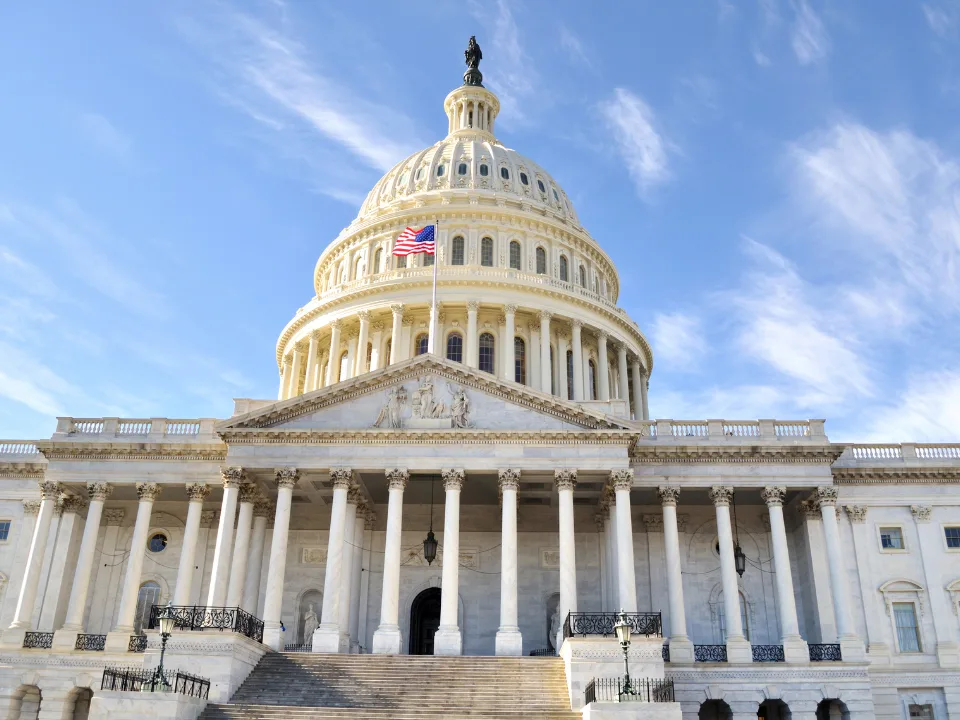White House Push for In-Person Work Meets Federal Office Return Hurdles
Plus: US construction remains resilient and is projecting a strong pipeline for 2024.
Together with
Good morning. Good morning. The U.S. government is struggling to bring federal employees back to offices. JLL forecasts a stable and modestly growing construction industry for 2024. Meanwhile, Shlomo Chopp shares his expertise in commercial real estate debt, discussing the current market’s challenges and opportunities.
Today’s issue is sponsored by BetterPitch. Focus on your deal, not your deck.
👋 First time reading? Sign up.
🎁 Want free merch? Share this.
Market Snapshot
|
|
||||
|
|
*Data as of 11/29/2023 market close.
BACK TO THE OFFICE
Federal Return-to-Office Efforts Falter Despite White House Push for In-Person Work
Like many private companies, the U.S. government is facing challenges in encouraging federal employees to return to office work, despite efforts to increase in-person work presence.
What happened: The Biden administration has been actively pressuring federal agencies to boost their office return rates. White House chief of staff Jeff Zients sent a directive to cabinet agencies to increase in-person work, but the goals set by the administration have not yet been met. The exact shortfall is unclear, as individual agencies are responsible for reporting their data. A Government Accountability Office review showed that most agencies used only a quarter or less of their headquarters’ capacity.
Financial implications: Federal agencies spend about $7 billion annually on operating and leasing office spaces, a significant expense regardless of actual usage. This issue is not only affecting Washington, D.C., but also other regions with large federal workforces, like Boston and Denver. The low occupancy rates are having a detrimental impact on local businesses and landlords, who rely on commuters for their livelihood.
Varied agency responses: Some federal agencies, like the Department of Veterans Affairs and the U.S. Agency for International Development, have successfully implemented new workplace policies, while others lag behind. The issue of federal return-to-office policies is gaining political traction, with some Republicans calling for legislation to enforce pre-pandemic schedules. The District of Columbia, for instance, has seen a record office vacancy rate, and various agencies are reducing their space as leases expire.
➥ THE TAKEAWAY
Balancing act: The struggle to bring federal workers back to the office reflects a broader trend of balancing workplace flexibility and operational needs. Cities have been more effective than the federal government in this respect, recognizing the economic impact on property values and tax revenues. This ongoing issue illustrates the complex dynamics of post-pandemic workplace strategies and the need for adaptable approaches.
A MESSAGE FROM BETTERPITCH
Gain Credibility With a BetterPitch Track Record Pitch Deck
Whether you need a fundraising deck, a corporate overview and track record deck, or investor reporting collateral, BetterPitch has you covered. The best part? BetterPitch completes all design, copywriting, and market research.
That’s right, they pull data both on an asset and market level and illustrate the research to support your investment thesis. Your days of moonlighting as a designer and analyst are over.
BetterPitch is the plug-and-play option to deliver an institutional quality pitch deck that leads to more effective fundraising. The best part? They deliver the final product in a PowerPoint file for you to use on future deals!
LOOKING FORWARD
Strong CRE Construction Pipeline Expected Throughout 2024
JLL’s 2024 forecast for the construction industry predicts more stability and modest cost growth, balancing higher interest rates, slower private starts, and a strong project pipeline in the U.S.

Annual average prices for construction materials, YoY change. (JLL Research, BLS)
By the numbers: The report highlights the improvement in dealing with costs, supply chains, and sector-specific needs compared to the previous year. JLL projects modest growth of 2–4% in total construction costs next year, with shorter lead times and more stable prices for materials. However, labor shortages are expected to persist, leading to an increase in construction wages.
Tech as a problem-solver: The construction industry is facing labor shortages, leading to falling productivity. Contractors are urged to prioritize retention and embrace tech investments and alternative production strategies. While AI and robotics can help alleviate labor constraints, they won’t fully solve the worker shortage. The construction industry needs to find innovative solutions.
Impact of higher interest: Although higher interest rates and declining private starts have not significantly slowed down construction, JLL anticipates potential impacts in 2H24 as projects in the pipeline are delivered. Declining architectural billings, particularly in September, may have an effect later in the year. However, additional public spending on infrastructure and manufacturing construction is expected to minimize the spending slowdown.
Supply chain volatility: While supply chains are currently manageable, there are potential threats that could create volatility and push prices up. Natural disasters, trade conflicts, and geopolitical tensions may be heightened during the 2024 election year and could impact the supply chain. The construction industry needs to be prepared for potential challenges and disruptions.
➥ THE TAKEAWAY
Strategies for success: JLL offers three core strategies for success in the construction industry in 2024. Firstly, prioritizing retention and investing in technology and alternative production strategies will help address labor constraints and improve productivity. Secondly, monitoring and adapting to the impact of higher interest on construction spending is crucial for project planning and delivery. Lastly, being prepared for potential volatility and mitigating risks associated with natural disasters and trade conflicts.
TRENDING HEADLINES
-
Good enough: The White House ups the pressure on federal agencies to increase the return-to-office rate even as DC’s office vacancy rate hits a record 20.3%.
-
From the ashes: Under new ownership, a former Bed, Bath & Beyond brand reopened 11 stores after bankruptcy and continues to cater to expectant parents.
-
Navigating the shift: MyEListing.com analyzes the potential depth of an impending dip in the US CRE market, highlighting shifts in remote work and the impact on office spaces.
-
Multifamily mayhem: US multifamily rental housing has had a great run these past few years, but it may finally be facing a critical test in 2024 and beyond.
-
A very old problem: Senior housing is increasingly out of reach for most of the middle class, but a new senior housing model might be able to turn things around.
-
Funding fizzles: California-based startup Veev, known for modular construction, faces closure after failing to secure enough funding, impacting 400 employees.
-
Property surrender: The surrender of office buildings to lenders is on the rise, with 43% of deed-in-lieu-of-foreclosure transactions in 2Q23 coming from the office sector, over 2x 2022’s average.
-
Rethinking rentals: Key trends for the rental housing market in 2024 include the ongoing affordability crisis, rising operational costs, and increasing regulations.
NAVIGATING DISTRESS
Current Challenges, Opportunities in Distressed US CRE Market
Shlomo Chopp, with his vast experience in commercial real estate debt, offers insights into navigating the market’s current distressed period, highlighting both challenges and opportunities.
The stress: The current CRE market echoes the turmoil of the 2008 financial crisis, with its own set of distinct challenges. Properties in the sector, ranging from office spaces to retail outlets, are grappling with changes driven by technological advancements, shifts in consumer behavior, and the impact of remote work trends. These changes are taking place against a backdrop of rising interest rates, which affect the market’s overall yield and stability.
The complicated world of CMBS: Commercial Mortgage-Backed Securities (CMBS) have a profound impact on the CRE market. While offering attractive interest rates and accessibility to a wide range of borrowers, CMBS loans come with intricate terms that can be challenging to navigate. This complexity was highlighted during the COVID-19 pandemic, as property owners faced unprecedented challenges such as lockdowns and lease terminations, leading to increased loan delinquencies and financial strain.
Between the lines: Special servicers are pivotal in managing CMBS loans, especially when borrowers default. Their primary focus is to protect the interests of bondholders, often at the expense of the borrowers. This can result in borrowers facing unexpected fees, stringent terms, and a loss of control over their financial situation, making it difficult for them to successfully negotiate or resolve loan issues.
➥ THE TAKEAWAY
Big picture: Despite the myriad challenges, the distressed CRE market presents unique opportunities for informed and strategically minded investors. The surge in demand for distressed assets has seen large private equity firms and real estate operators actively seeking and capitalizing on these opportunities. They are identifying potential in off-market deals and leveraging their expertise to turn challenges into profitable ventures.
QUICK HITS
📖 READ: While many people associate new home construction with gentrification, a recent analysis reveals that increased housing supply can actually drive down housing costs.
🎧 LISTEN: Is the Corporate Transparency Act the end of entity anonymity? Best Ever CRE explores what impact this new act, which goes into effect in January 2024, will have on real estate investors and operators.
CHART OF THE DAY

Philadelphia is outperforming many major U.S. office markets in managing the national trend of downsizing office spaces, with less unwanted office space returned compared to nine of the top 15 U.S. office metros.
What did you think of today’s newsletter? |




















